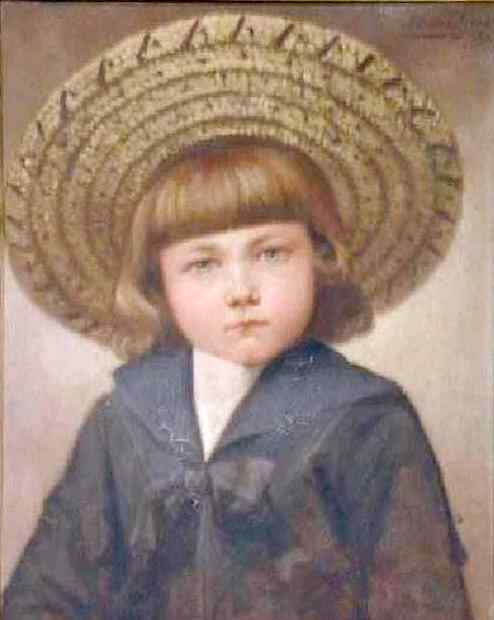
Belgian Boys Clothes Garments: Sailor Headwear

Figure 1.--This portrait of a "Young Boy with a Hat" is unidentified. It was painted by Belgian artist Adrien Geefs in 1898. We thus assume the boy is Belgian. Boys did not always wear sailor suits with these wide-brimmed sailor hats, but this boy did.
|
|
Belgian boys in the late 19th and early 20th century commonly wore sailor hats and caps. Although Belgium had virtually no navy, sailor hats and caps along with sailor suits were as commonly worn in Belgium as in the neighboring Netherlands, Germany, and France where they were also very popular. Younger boys commonly wore wide-brimmed sailor hats when dressing up in the late 19th and early 20th century. These wide-brimmed sailor hats were worn with both sailor suits and many other outfits. Older boys more commonly wore a variety of sailor cap styles. The most cap styles generally corresponded to the uniform styles actually adopted by the country's navy. Given the small size of the Belgian navy, however, the styles worn by boys in neighboring countries may have been of more significance in influencing Belgian styles. Sailor caps were most commonly worn with sailor suits and unlike sailor hats, less commonly with other outfits. Styles were influenced by both France and Germany as well as the Netherlands. Until the 1930s, boys usually wore hats or caps with their sailor suits as the customm of wearing headwwear was much more common than in the later 20th century. The boy shown here has bangs and wears a fairly plain blue sailor suit with an enormous wide-brimmed sailor hat. It looks to be a straw hat with a very elablorate weaving pattern (figure 1).
The Sailor Style
The sailor suit and accompanying sailor headwear was one of the most popular styles ever worn by boys and subsequently girls as well. The style originted England, but soon spread thrroughout Europe. It was worn in both countries with and without important navies. Belgian boys in the late 19th and early 20th century commonly wore sailor hats and caps. Although Belgium had virtually no navy, sailor hats and caps along with sailor suits were as commonly worn in Belgium as in the neighboring Netherlands, Germany, and France where they were also very popular. Styles were influenced by both France and Germany as well as the Netherlands. Until the 1930s, boys usually wore hats or caps with their sailor suits as the customm of wearing headwwear was much more common than in the later 20th century.
Sailor Hats
Younger boys commonly wore wide-brimmed sailor hats when dressing up. Saolor hats were commonly worn after the mid-19th century and continued to be worn through the early 20th century. They generally disappeared after World War I (1914-18). While sailor hats disappeared after the War, sailor caps were sill commonly worn.The most common sailor hat was the broad-brimmed straw hat. These wide-brimmed sailor hats were worn with both sailor suits and many other outfits. While they are most associated with sailor suits, sailor hats ere worn eith other outfits, especially dressy ouytfit like Little Lord Funtleroy suits. The Belgian boy shown here has bangs and wears a fairly plain blue sailor suit with an enormous wide-brimmed sailor hat. It looks to be a straw hat with a very elablorate weaving pattern (figure 1). Sailor hats were worn to school, but rarely after Worl War I.
Sailor suits were first worn with sailor hats, but sailor caps soon followed. The importantvstyles of sailor caps followed actual naval uniform styles. Older boys more commonly wore a variety of sailor cap styles. The most cap styles generally corresponded to the uniform styles actually adopted by the country's navy. Given the small size of the Belgian navy, however, the styles worn by boys in neighboring countries may have been of more significance in influencing Belgian styles. Sailor caps were most commonly worn with sailor suits and unlike sailor hats, less commonly with other outfits. They were a style that were commonly worn to school, but less commonly after World War I. The sailor cap might be worn casually. We also notice it being worn with sailor suits for formal events like First Commnion and Confirmation.
HBC

Navigate the Boys' Historical Clothing Web Site:
[About Us]
[Introduction]
[Biographies]
[Chronology]
[Climatology]
[Clothing]
[Disease and Health]
[Economics]
[Freedom]
[Geography]
[History]
[Human Nature]
[Ideology]
[Law]
[Nationalism]
[Presidents]
[Religion]
[Royalty]
[Science]
[Social Class]
[Bibliographies]
[Contributions]
[FAQs]
[Dutch glossary]
[French glossary]
[Images]
[Links]
[Registration]
[Tools]
[Children in History Home]
Navigate the Boys' Historical Clothing Belgian pages:
[Return to the Main Belgian headwear page]
[Return to the Main Belgian garment page]
[Belgian catalogs
[Belgian choirs]
[Belgian movies]
[Belgian royals]
[Belgian schools]
[Belgian youth groups]
Created: January 25, 2002
Last updated: October 17, 2003



